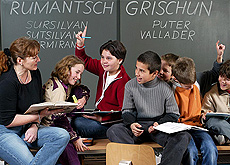Controversy rages over standardised Romansh

The standard version of Romansh, Rumantsch Grischun (RG), has raised passions ever since its introduction more than 20 years ago.
Opinions are divided across the Romansh community, with supporters saying RG could be the future of Romansh, and opponents insisting it could spell the end of the minority language.
Traditionally, five different Romansh idioms have been spoken in the southeastern canton of Graubünden (Sursilvan, Vallader, Surmiran, Sutsilvan and Puter).
Added to this is RG, which was created in 1982 to provide Romansh speakers with a standard written language.
RG has proven popular with the federal and cantonal authorities. It is the official language used by the government for its dealings with Romansh speakers and has been used in Graubünden for official documents since 2001.
Graubünden wants to introduce it into all Romansh primary schools by 2010. In this way, it hopes to cut costs, as currently it has to provide educational materials in all five idioms.
RG is now also used in some sections of the media, including public service broadcaster Radio and Television Romansh (RTR) and the newspaper, La Quotidiana.
Credibility
Lia Rumantscha, the Romansh promotion organisation based in the cantonal capital, Chur, was one of the driving forces behind RG. It hoped that the unified language would help cement the fragmented Romansh identity and give Romansh more credibility.
“It is sometimes a bit ridiculous when we go and try to represent Romansh people and we are confronted with questions from the [majority] German-speaking part of the country about why we are asking for five different books to be published,” Lia Rumantscha’s Andrea Rassel told swissinfo.
It was also hoped that RG would give Romansh a boost, at a time when the number of speakers is diminishing. Currently only 0.5 per cent of the Swiss population speak the language.
But these arguments have failed to convince people in the regions where the local idioms have survived for centuries.
These include Annemieke Buob, president of a branch of the Uniun dals Grischs – another organisation which promotes Romansh – in Puter-speaking Celerina in the Upper Engadine.
Artificial
“Romansh is something which has grown and become established, you cannot replace that with another language that has been artificially constructed,” Buob told swissinfo.
She added that RG could not take the place of German either, which is the language many bilingual Romansh-speakers use at work.
“The cantonal government and Lia Rumantsha want to impose RG, especially as a written language. In Engadine this is not wanted and people are worried they will lose their own idioms,” she added.
Buob said that much depended on if RG was introduced into schools and whether children would be able to identify with it as a “language of the heart” rather than as one of a small elite.
Parents also fear that their children could be overloaded. “Children already have to learn Swiss German and High German, and if you add two types of Romansh as well, that’s a lot,” said Buob.
Way forward
But proponents of RG are convinced the unified version is the way forward for the threatened language and reject accusations that it is too artificial.
“All the words already exist. It’s rather a combination, like Luther did for German and Dante with Italian,” Bernard Cathomas, the head of RTR and champion of the unified language, told swissinfo.
However, some supporters accept that the introduction of RG has not been optimal.
“At first officials said it’s only going to be used for federal laws and communications with the whole Romansh group,” explained Lia Rumantscha’s Rassel.
“With the introduction into primary schools… it becomes very close to people if children have to learn the [new] language.”
Rassel said that, ideally, the situation could become similar to that of German-speaking Switzerland, where the Swiss German dialect is used on an everyday basis but standard High German is taught at schools.
“People don’t write as they speak and if people realise that the step to RG is not a very big one then I am sure we might gain a lot of people for this project,” he said.
swissinfo, Isobel Leybold-Johnson in Chur and Celerina
RG was created in 1982 by Zurich professor Heinrich Schmid. He based it on three idioms: Sursilvan, Vallader and Surmiran.
Where possible, a form common to all three idioms was taken. This can be seen in the word for peace: pasch.
Where this didn’t work, sometimes a smaller idiom was used, such as Sutsilvan – gea (yes), or even a regional variant of an idiom, such as jau (I), which comes from the Jauer dialect of Val Müstair.

In compliance with the JTI standards
More: SWI swissinfo.ch certified by the Journalism Trust Initiative









You can find an overview of ongoing debates with our journalists here . Please join us!
If you want to start a conversation about a topic raised in this article or want to report factual errors, email us at english@swissinfo.ch.